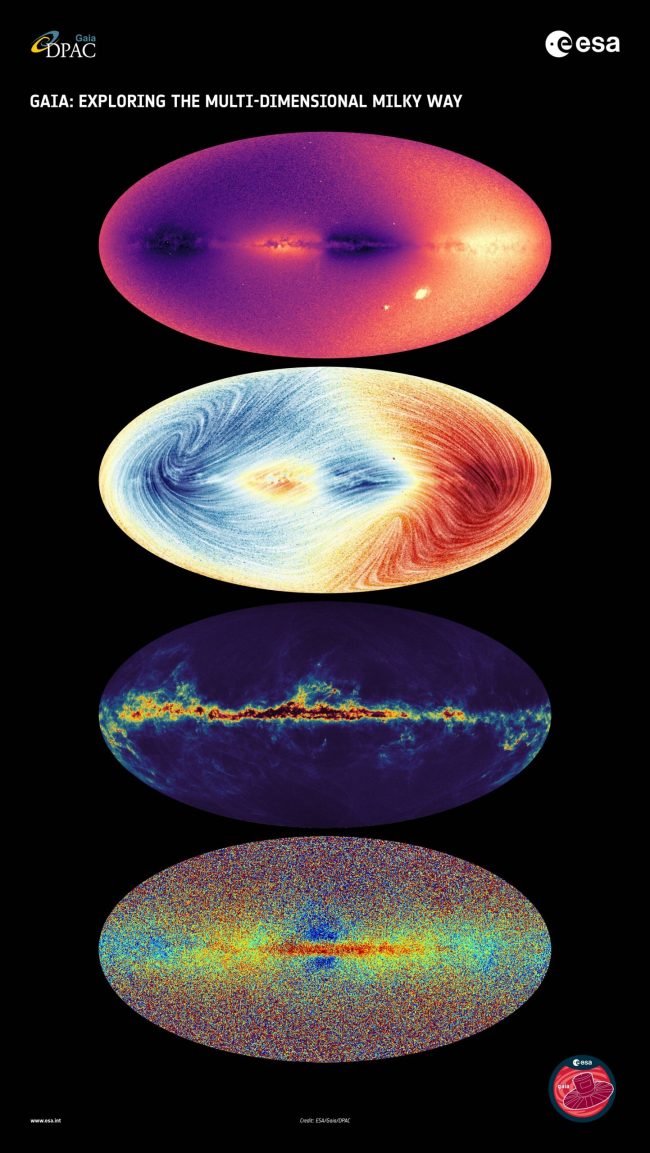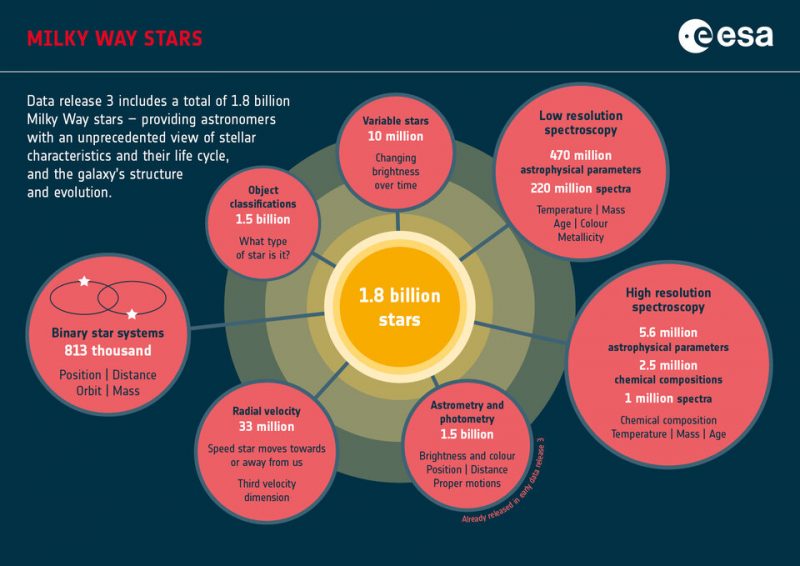A short video navigating through the #GaiaSky DR3-large dataset (~122 million stars) in real time. #GaiaDR3 is really amazing. pic.twitter.com/cdKErgsxJC
— Gaia Sky (@GaiaSky_Dev) June 14, 2022
Gaia 3rd data release June 13
Gaia is a space observatory of the European Space Agency (ESA), launched in 2013 and expected to operate until 2025. It’s located at the L-2 point, in the parking space in the Earth-sun system, same as NASA’s James Webb Space Telescope, successor to Hubble. Gaia’s job is to look close to home, at our own island of stars in space, our Milky Way galaxy. Gaia’s data about our home galaxy has been released to scientists in batches, with the first data release in 2016, and the second in 2018. Today – Monday, June 13, 2022 – marked Gaia’s third data release.
It’s hard to overemphasize the wealth of fascinating discoveries about our galaxy, and its stars and star systems, made possible by Gaia. If you’re old enough to remember how mind-boggling it was when the Voyagers first saw the outer planets … that’s what Gaia is doing for our Milky Way at large. The process is that ESA releases the data, and then astronomers mine it to find out all they can. Ultimately, Gaia data will be used to create what ESA said on June 13 will be:
… the most accurate and complete multi-dimensional map of the Milky Way (ever).
Click here for some results from Gaia’s first 2 data releases

Gaia measures how stars move
Gaia does what’s called astrometry: essentially, it makes exceedingly precise measurements of the positions of stars. When I started writing about astronomy, back in the 1970s, I thought astrometry was one of the least glamorous ways to study the heavens. Now I consider Gaia to be supremely fascinating. Why has it changed for me? Consider that, in the 1970s, we often spoke of the “fixed stars.” For example, we knew stars in our Milky Way galaxy move around the galaxy’s center, but, over a single human lifetime, we couldn’t see them move. Even 1970s astrometry could barely detect their movement. But that was decades before Gaia.
Gaia can measure star positions very precisely. It takes a measurement, and then it comes back some time later and measures that same star’s position again. And again. And it has done that since 2013 for about two billion stars in our Milky Way galaxy.
And so Gaia gives astronomers something they’ve never had before. It gives them a large-scale and very precise look at how the objects in our Milky Way are moving over time.
What’s new in the 3rd data release?
But that’s not all Gaia does. ESA said on June 13:
Gaia’s third full data set contains new and improved details for almost 2 billion objects in our Milky Way. The catalog includes new information, including chemical compositions, stellar temperatures, colors, masses, ages, and the speed at which stars move toward or away from us. Much of this information is revealed by spectroscopy, a technique in which starlight is split into its constituent colors (like a rainbow). It also lists special subsets of stars, like those that change brightness over time. Also new in this data set is the largest catalog yet of binary stars in the Milky Way, thousands of solar system objects such as asteroids and moons of planets, and millions of galaxies and quasars outside the Milky Way.


Gaia can detect ‘strange’ starquakes
In the video below, the frequency of rotating – and pulsating – stars seen by Gaia was increased 8.6 million times. That increase shifted the frequency into a range that’s audible by humans. It’s a beautiful thing to think that – over some long, slow frequency, which humans wouldn’t naturally hear – stars in our galaxy emit the strange “music” you hear in the video.
Gaia had earlier taken measurements from stars that swell and shrink periodically, while keeping their spherical shape. But – with this third data release – Gaia saw a different sort of vibration: “more like large-scale tsunamis,” ESA said, adding:
These nonradial oscillations change the global shape of a star and are therefore harder to detect.
Nonradial oscillation modes cause a star’s surface to move while it rotates, as shown in the animation (below). Dark patches are slightly cooler than bright patches, giving rise to periodic changes in the brightness of the star.
The DNA of stars
With the June 13, 2022, data release, ESA said that Gaia:
… is revealing the largest chemical map of the galaxy coupled to 3D motions, from our solar neigborhood to smaller galaxies surrounding ours.
Some stars contain more ‘heavy metals’ than others. During the Big Bang, only light elements were formed (hydrogen and helium). All other heavier elements – called metals by astronomers – are built inside stars. When stars die, they release these metals into the gas and dust between the stars called the interstellar medium, out of which new stars form. Active star formation and death will lead to an environment that is richer in metals. Therefore, a star’s chemical composition is a bit like its DNA, giving us crucial information about its origin.
With Gaia, we see that some stars in our galaxy are made of primordial material, while others like our sun are made of matter enriched by previous generations of stars. Stars that are closer to the center and plane of our galaxy are richer in metals than stars at larger distances. Gaia also identified stars that originally came from different galaxies than our own, based on their chemical composition.
Overview of Gaia science
The video below will give you an overview of Gaia’s third data release:
Bottom line: On June 13, 2022, ESA released the Gaia space observatory’s third data set. It contains data on “strange” starquakes and star DNA.











